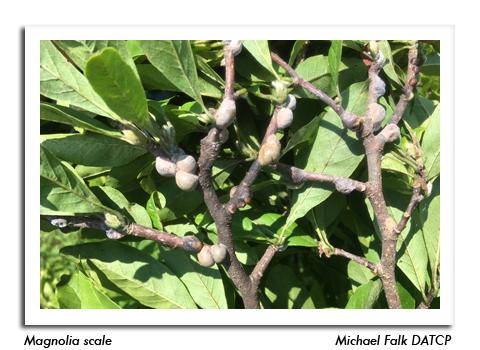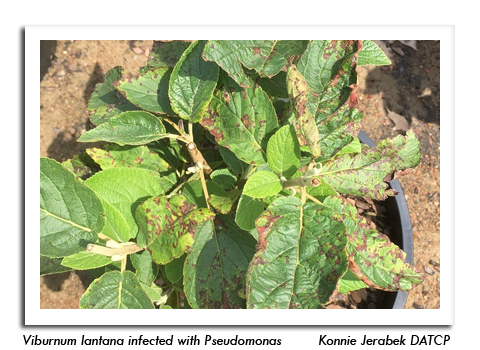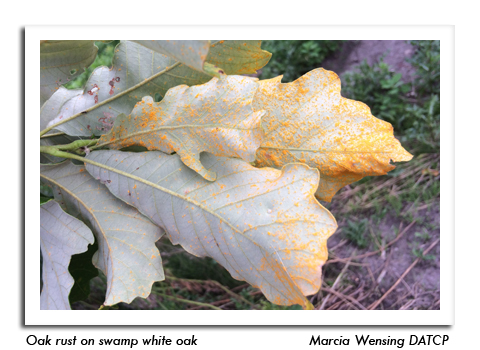
 |
|
|
Nursery & Forest
Volume 62 Number 17 Date 08/24/2017 MAGNOLIA SCALE - This largest scale insect found in the United States was observed on magnolias in southeast Wisconsin in the past week. Magnolia scale can range up to ½ inch in size and are similar in appearance to small plant galls. The female scales are at times covered with white wax. This pest damages magnolias by removing sap and producing sticky honeydew that promotes sooty mold growth. Magnolia varieties commonly infested include 'Royal star', saucer, cucumbertree, and lily magnolia. Gardeners and nursery managers are advised to begin inspecting their magnolia trees and shrubs now for scales, and consider treating heavily infested plants with a crawler spray in late September. Minor infestations can be removed any time of the year by pruning out branches with scales. BACTERIAL LEAF SPOT - Nursery inspectors found bacterial leaf spot caused by Pseudomonas spp. on a variety of ornamental plants, including Magnolia X loebneri 'Leonard Messel', spirea, and viburnum. Pseudomonas spp. can be a year-round problem in nurseries and greenhouses whenever leaves remain wet due to overhead watering, splashing water, or plant crowding. Disease development is highly dependent on cool and wet conditions, therefore leaf spot occurrence can be limited by avoiding sprinkler irrigation, spacing plants properly, removing infected leaves early, and rotating susceptible plants away from areas where infected plants were grown. Pseudomonas bacteria are not controlled with fungicides. Sanitation is the most effective management practice. PINE-OAK GALL RUST - A heavy rust infection was noted on swamp white oaks in Washington County this week. The conspicuous orange pustules that appear on leaf undersides in late summer and fall are diagnostic. Although the effects of this fungus are insignificant on oak, it can be devastating for the alternate host, pine, by causing the formation of oblong galls on the branches and trunks. The galls reduce branch growth, lead to branch death, and may kill young pine trees. Older, established pines may be disfigured, but the overall health is usually not affected. Pruning to remove galls or infected pine branches in late winter or early spring will reduce the amount of spores produced that will infect nearby pine and oak trees. No control measures are feasible or recommended on oak trees. In addition, pines should be inspected prior to purchase to ensure that they are free from galls. SPRUCE BUDWORM - A DNR report indicates that damage caused by this conifer pest has been less apparent than in past years. Although the larvae are present throughout northern Wisconsin this summer, their damage has not been as visible. DNR Forest Health Specialists suspect that strong storms and heavy rainfall earlier this season may have washed caterpillars from the trees and caused more damaged needles to drop than normally would, masking the defoliation. DATCP inspectors also recently found several severely infested Black Hills spruce in a St. Croix County nursery. For smaller nursery or backyard infestations, Bt sprays targeting this insect can be effective if applied weekly to spruce foliage in May when the larvae are small. June and July applications should help to control infestations on new growth. -- Tim Boyle, DATCP Nursery Inspector 




|
|
|